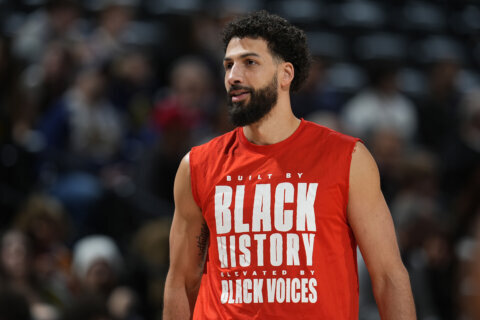How Porzingis' game is informed by analytics originally appeared on NBC Sports Washington
WASHINGTON — Kristaps Porzingis is intrigued by the numbers, to the degree he thinks through his offensive game in terms of points per possession, i.e. which types of plays are more efficient than others. He keeps an open mind with the Wizards’ coaching staff when they present him with analytics and especially when that message comes from assistant coach Dean Oliver.
Oliver joined the Wizards staff in 2019 for that purpose, with a long track record as a visionary in basketball analytics. Porzingis is aware of that history and has been working with Oliver ever since he landed in Washington in a February trade.
After the Wizards’ practice on Monday, Porzingis explained how Oliver has helped him change several areas of his game through a data-driven approach. One point of emphasis has made a significant difference; his free throws. Porzingis has long been a high percentage shooter from the line, but is now getting there more often than ever.
Porzingis is averaging a career-high 6.8 free throw attempts per game, most on the Wizards. It’s the same amount he averaged down the stretch of last season, as his free throw rate jumped soon after his trade to Washington.
“The coaches love when you can get to the free throw line because it’s 1.6 points per possession, depending on what percentage you shoot. So, it’s one of the most effective things you can do on offense,” Porzingis said.
How he’s getting there so often relates to the way Porzingis is used in the Wizards’ offense. He credited getting more post-up opportunities, which head coach Wes Unseld Jr. broke down into more specific detail.
As Unseld Jr. explained it, they are utilizing Porzingis a lot more than most centers are in catch-and-shoot plays off screens. Porzingis is tied for third among centers in catch-and-shoot attempts per game (5.3) this season.
Those actions sometimes lead to mismatches when other teams switch, leaving Porzingis alone against smaller defenders. When Porzingis is isolated in the mid-post against a much shorter player, he has a knack for making them pay for when they reach for steals.
“Guys get hands on the ball and he reads it. He’s a smart player, a smart offensive player who has kind of learned some of those tricks throughout his career. But I think putting him in those situations has put teams at a deficit some nights,” Unseld Jr. said.
Porzingis says he has learned how to capitalize on those situations through experience, between understanding the timing of NBA defenders and how games are officiated. He believes he has a better grasp of how to generate contact and sell it to the referees than he did earlier in his career.
Another area Oliver, whom Porzingis described as an “O.G. of analytics,” has affected Porzingis’ game is on the defensive end. Porzingis has begun to incorporate what is known as the ‘Kornet Contest,’ a defensive move credited to Celtics big man Luke Kornet.
Basically, it’s when a big man jumps to contest an outside shot, but not anywhere close enough to block the shot. The goal is to block the shooter’s view of the rim, all while being far enough away to not risk fouling them.
It seems to work for Kornet, who calls it the ‘Eclipse,’ because he’s 7-foot-2. Porzingis is 7-foot-3, so he is a logical candidate to employ it himself.
And, according to Porzingis, Oliver says it’s effective.
“I actually works, yeah,” Porzingis said. “I mean, we don’t have a lot of examples, but as much as we have, while Kornet’s been doing it, it’s been working. So, we’re trying it also. I don’t know what our numbers are, but at least from my feeling on the court, I feel like they have missed a bunch of threes when I have done the Kornet jump. So, I’ll keep doing it. “
In addition to blocking the shooter’s sightline, Porzingis has noticed another benefit. Against the Clippers, he did the ‘Kornet Contest’ against Terrence Mann, who was deterred from shooting a three and instead tried to drive around Porzingis.
“Even if you jump in the air, you come down and you’re still there for the defense because he’s coming at you and you still have that space. I got a deflection and we got the ball. I know the coaches on the bench were excited about that one, so I think it’s going to be a thing that we’ll have to keep using more,” Porzingis said.
At 27 years old and in his seventh NBA year, Porzingis is having one his best seasons yet. His game continues to evolve and, in some cases, in direct response to the data.







